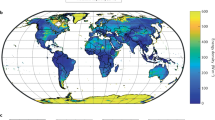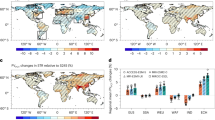Abstract
It is still possible to limit greenhouse gas emissions to avoid the 2 °C warming threshold for dangerous climate change1. Here we explore the potential role of expanded wind energy deployment in climate change mitigation efforts. At present, most turbines are located in extra-tropical Asia, Europe and North America2,3, where climate projections indicate continuity of the abundant wind resource during this century4,5. Scenarios from international agencies indicate that this virtually carbon-free source could supply 10–31% of electricity worldwide by 2050 (refs 2, 6). Using these projections within Intergovernmental Panel on Climate Change Representative Concentration Pathway (RCP) climate forcing scenarios7, we show that dependent on the precise RCP followed, pursuing a moderate wind energy deployment plan by 2050 delays crossing the 2 °C warming threshold by 1–6 years. Using more aggressive wind turbine deployment strategies delays 2 °C warming by 3–10 years, or in the case of RCP4.5 avoids passing this threshold altogether. To maximize these climate benefits, deployment of non-fossil electricity generation must be coupled with reduced energy use.
This is a preview of subscription content, access via your institution
Access options
Subscribe to this journal
Receive 12 print issues and online access
$209.00 per year
only $17.42 per issue
Buy this article
- Purchase on Springer Link
- Instant access to full article PDF
Prices may be subject to local taxes which are calculated during checkout



Similar content being viewed by others
References
Stocker, T. F. et al. in Climate Change 2013: The Physical Science Basis (ed Stocker, T. F. et al.) 1535 (2013).
OECD/IEA, Technology Roadmap. Wind Energy 63 (IEA, 2013).
OECD/IEA, Technology Roadmap: China Wind Energy Development Roadmap 2050 56 (IEA, 2011).
Pryor, S. C. & Barthelmie, R. J. Assessing climate change impacts on the near-term stability of the wind energy resource over the USA. Proc. Natl Acad. Sci. USA 108, 8167–8171 (2011).
Chen, L., Pryor, S. C. & Li, D. Assessing the performance of Intergovernmental Panel on Climate Change AR5 climate models in simulating and projecting wind speeds over China. J. Geophys. Res. 117, D24102 (2012).
Wiser, R. et al. in Renewable Energy Sources and Climate Change Mitigation: Special Report of the Intergovernmental Panel on Climate Change (ed Edenhofer, O. et al.) 1075 (Cambridge Univ. Press, 2012).
Van Vuuren, D. P. et al. The representative concentration pathways: An overview. Climatic Change 109, 5–31 (2011).
Jacobson, M. Z. & Archer, C. L. Saturation wind power potential and its implications for wind energy. Proc. Natl Acad. Sci. USA 109, 15679–15684 (2012).
Marvel, K., Kravitz, B. & Caldeira, K. Geophysical limits to global wind power. Nature Clim. Change 3, 118–121 (2013).
Vidal, O., Goffe, B. & Arndt, N. Metals for a low-carbon society. Nature Geosci. 6, 894–896 (2013).
Vose, R. S. et al. Monitoring and understanding changes in extremes: Extratropical storms, winds, and waves. Bull. Am. Meteorol. Soc. 95, 377–386 (2014).
Pryor, S. C., Barthelmie, R. J. & Schoof, J. T. Past and future wind climates over the contiguous USA based on the NARCCAP model suite. J. Geophys. Res. 117, D19119 (2012).
Markandya, A. & Wilkinson, P. Electricity generation and health. Lancet 370, 979–990 (2007).
Smith, C. M., Barthelmie, R. J. & Pryor, S. C. In situ observations of the influence of a large onshore wind farm on near-surface temperature, turbulence intensity and wind speed profiles. Environ. Res. Lett. 8, 034006 (2013).
Vautard, R. et al. Regional climate model simulations indicate limited climatic impacts by operational and planned European wind farms. Nature Commun. 5, 3196 (2014).
OECD/IEA, Key World Energy Statistics 82 (2013).
IEA World Balancehttp://www.iea.org/Sankey/index.html#?c=World&s=Balance (2014).
OECD/IEA, World Energy Outlook. Ch 6. Renewable Energy Outlook 197–232 (International Energy Agency, 2013).
Davis, S. J., Caldeira, K. & Matthews, H. D. Future CO2 emissions and climate change from existing energy infrastructure. Science 329, 1330–1333 (2010).
OECD/IEA, Highlights 138 (IEA, 2012).
Allen, M. R. et al. Warming caused by cumulative carbon emissions towards the trillionth tonne. Nature 458, 1163–1166 (2009).
Rogelj, J. et al. Emission pathways consistent with a 2 °C global temperature limit. Nature Clim. Change 1, 413–418 (2011).
Pacala, S. & Socolow, R. Stabilization wedges: Solving the climate problem for the next 50 years with current technologies. Science 305, 968–972 (2004).
Allen, M. R. & Stocker, T. F. Impact of delay in reducing carbon dioxide emissions. Nature Clim. Change 4, 23–26 (2014).
Peters, G. P. et al. COMMENTARY: The challenge to keep global warming below 2 degrees C. Nature Clim. Change 3, 4–6 (2013).
Masui, T. et al. An emission pathway for stabilization at 6 W m−2 radiative forcing. Climatic Change 109, 59–76 (2011).
Riahi, K. et al. RCP 8.5—A scenario of comparatively high greenhouse gas emissions. Climatic Change 109, 33–57 (2011).
Thomson, A. M. et al. RCP4.5: A pathway for stabilization of radiative forcing by 2100. Climatic Change 109, 77–94 (2011).
Van Vuuren, D. et al. RCP2.6: Exploring the possibility to keep global mean temperature increase below 2 °C. Climatic Change 109, 95–116 (2011).
Global Wind Energy Council, Global Wind Report: Outlook 2012 51 (Greenpeace/Global Wind Energy Council, 2013) http://www.gwec.net/wp-content/uploads/2012/11/GWEO_2012_lowRes.pdf
Acknowledgements
This work was financially supported in part by NSF# 1067007 and 1019603 and DoE# DE-EE0005379.
Author information
Authors and Affiliations
Contributions
R.J.B. and S.C.P. designed the study. R.J.B. carried out most of the data analysis. R.J.B. and S.C.P. co-wrote the paper.
Corresponding author
Ethics declarations
Competing interests
The authors declare no competing financial interests.
Supplementary information
Rights and permissions
About this article
Cite this article
Barthelmie, R., Pryor, S. Potential contribution of wind energy to climate change mitigation. Nature Clim Change 4, 684–688 (2014). https://doi.org/10.1038/nclimate2269
Received:
Accepted:
Published:
Issue Date:
DOI: https://doi.org/10.1038/nclimate2269
This article is cited by
-
Competing for space? A multi-criteria scenario framework intended to model the energy–biodiversity–land nexus for regional renewable energy planning based on a German case study
Energy, Sustainability and Society (2023)
-
Co-benefits of carbon neutrality in enhancing and stabilizing solar and wind energy
Nature Climate Change (2023)
-
In situ synthesis of Bi3+-doped δ-MnO2 cathode to enhance the cycle stability for aqueous zinc-ion batteries
Journal of Solid State Electrochemistry (2023)
-
Focus on using nanopore technology for societal health, environmental, and energy challenges
Nano Research (2022)
-
Expert elicitation survey predicts 37% to 49% declines in wind energy costs by 2050
Nature Energy (2021)



